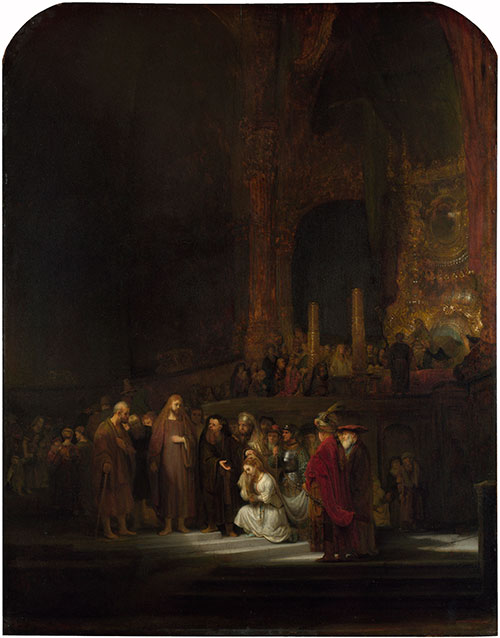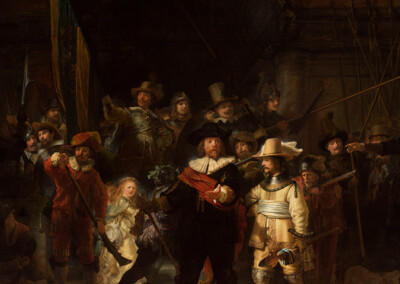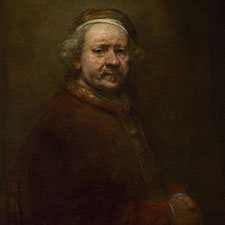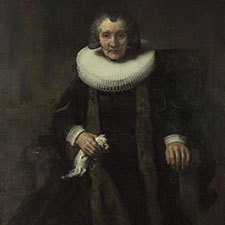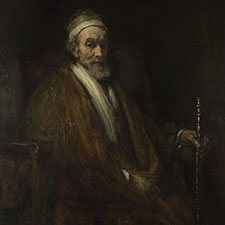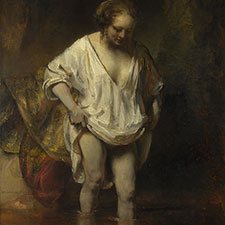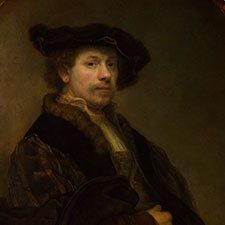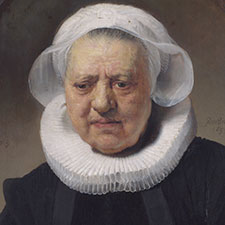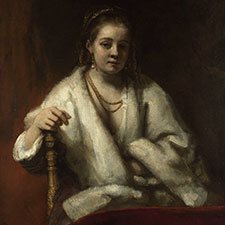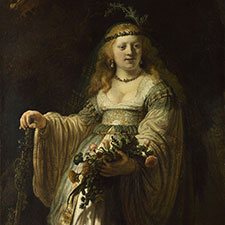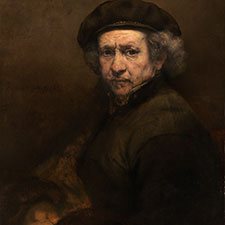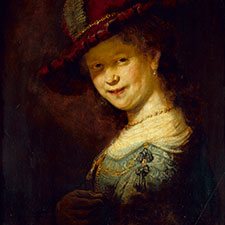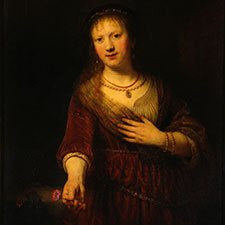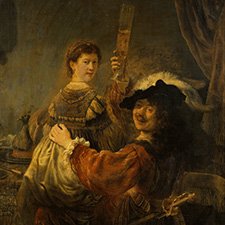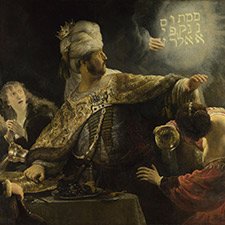Rembrandt, The Woman Taken in Adultery
1664Paintings sorted by Historical period | Painter | Subject matter | Pigments used
Overview
Rembrandt, The Woman Taken in Adultery is a masterful depiction of the well-known Bible story showing exceptional handling of color.
The pigment analysis revealed a limited palette consisting of red and yellow ochres, bone black, lead white, red lake, azurite, and vermilion.
Medium: oil Support: oak
Size: 83.8 x 65.4 cm
Art period: Baroque
National Gallery London
NG45
Painting in the Rembrandt Database
Characterization of this painting by the scientists of the Rembrandt Research Project (1):
“Fortunately, however, external evidence supporting the painting’s authenticity is so strong that all doubt can be excluded.”
(1) Ernst Van De Wetering, Rembrandt — The Woman taken in Adultery, London, The National Gallery, in A Corpus of Rembrandt Paintings, Volume 5 of the series, Stichting Foundation, Rembrandt Research Project, pp 355-370.
Story in the Bible
John 7:53-8:11 in the New Revised Standard Version:
A Woman Caught in Adultery
53 Then each of them went home, 1 while Jesus went to the Mount of Olives. 2 Early in the morning he came again to the temple. All the people came to him and he sat down and began to teach them. 3 The scribes and the Pharisees brought a woman who had been caught in adultery; and making her stand before all of them, 4 they said to him, ‘Teacher, this woman was caught in the very act of committing adultery. 5 Now in the law, Moses commanded us to stone such women. Now what do you say?’ 6 They said this to test him so that they might have some charge to bring against him. Jesus bent down and wrote with his finger on the ground. 7 When they kept on questioning him, he straightened up and said to them, ‘Let anyone among you who is without sin be the first to throw a stone at her.’ 8 And once again he bent down and wrote on the ground. 9 When they heard it, they went away, one by one, beginning with the elders; and Jesus was left alone with the woman standing before him. 10 Jesus straightened up and said to her, ‘Woman, where are they? Has no one condemned you?’ 11 She said, ‘No one, sir.’ And Jesus said, ‘Neither do I condemn you. Go your way, and from now on do not sin again.’
Related Paintings
Lucas Cranach the Younger, Jesus Christ and the woman taken in adultery, after 1532
Hermitage, St Petersburg
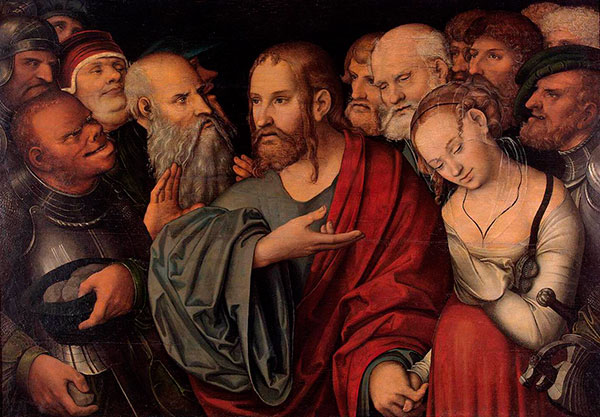
Pieter Bruegel the Younger, Christ and the Woman Taken in Adultery, ca 1600
Philadelphia Museum of Art
Guercino, Christ and the Woman Taken in Adultery, ca 1621
Dulwich Picture Gallery, London
Alessandro Turchi, Christ and the Woman Taken in Adultery, first half of the 17th-century
Private collection

Pigments
Pigment Analysis
This pigment analysis is based on the work of the scientists at the National Gallery London (1).
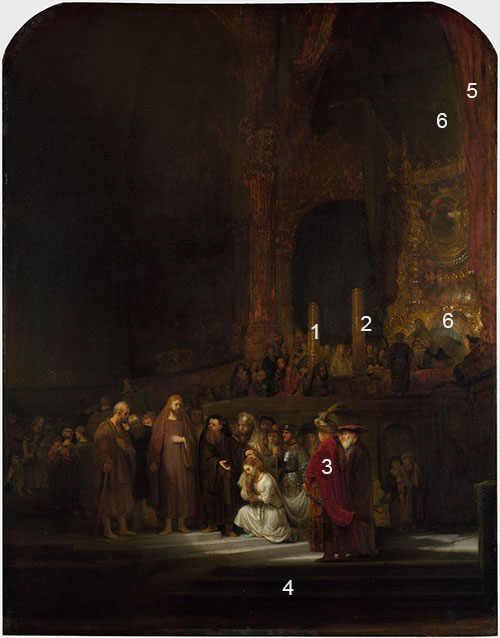
1 Yellow highlights on the throne to the left: pure lead-tin yellow.
2 White highlights on the throne to the right: pure lead white.
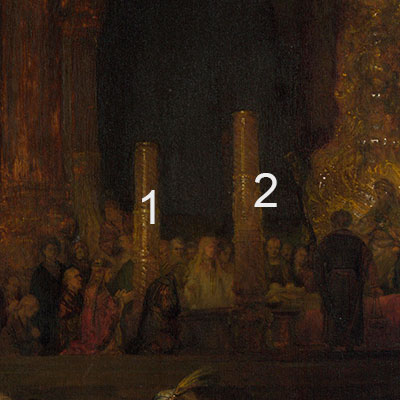
3 Deep crimson cloak: red lake glazes over a black underlayer.
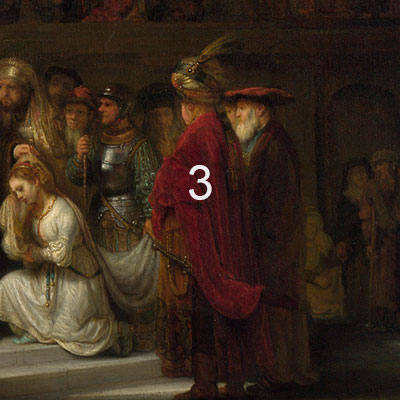
4 Dark foreground: the various tones are based on combinations of bone black, red and yellow lakes, and small amounts of red and yellow ochres and vermilion.

5 Warm brown area in the upper right corner: lower layer is painted in lead white, the surface glaze contains vermilion, ochres, lakes, and bone black.
6 Greenish and bluish areas: pigment mixtures containing azurite

References
(1) Bomford, D. et al., Art in the making: Rembrandt, New edition, Yale University Press, 2006, pp. 126-131.
Pigments Used in This Painting
Resources
See the collection of online and offline resources such as books, articles, videos, and websites on Rembrandt in the section ‘Resources on Painters‘
PowerPoint Presentations
Painter in Context: Rembrandt

A richly illustrated presentation on the painting technique and pigments employed by Hieronymus Bosch specially crafted for Art Education. (Number of Slides = 20)
- Each presentation starts with the basic resources on the painter such as his biography, main catalogs of his paintings, and a bibliography.
- Next, you find slides describing the painting technique of the artist and the pigments he usually employed in his work.
- The majority of the slides show examples of paintings containing the specific pigments.
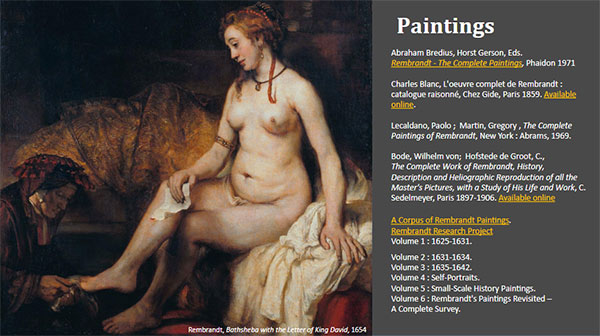
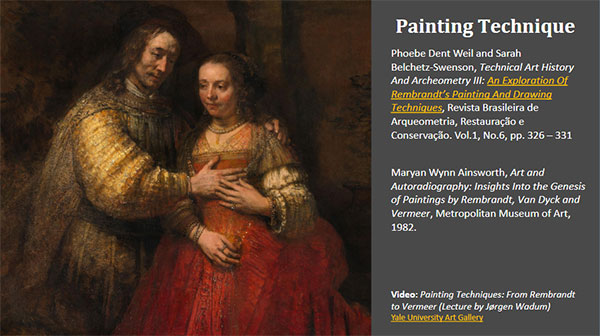
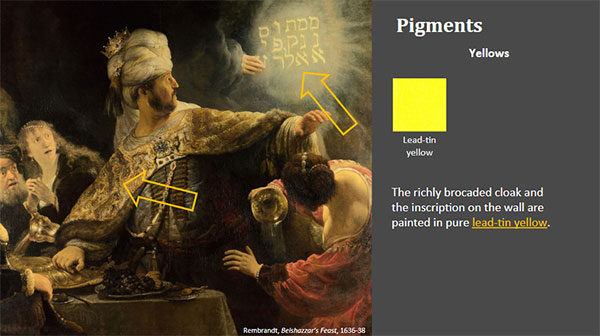
The majority of the slides show important examples of paintings where Rembrandt employed specific pigments. The slides are organized according to the color of the pigments.
Publications and Websites
Publications
(1) Bomford, D. et al., Art in the making: Rembrandt, New edition, Yale University Press, 2006, pp. 126-131.
(2) Michael Podro, Rembrandt’s Woman Taken in Adultery, Journal of the Warburg and Courtauld Institutes, Vol. 50 (1987), pp. 245-252.
(3) Ernst Van De Wetering, Rembrandt — The Woman taken in Adultery, London, The National Gallery, in A Corpus of Rembrandt Paintings, Volume 5 of the series, Stichting Foundation, Rembrandt Research Project, pp 355-370.

